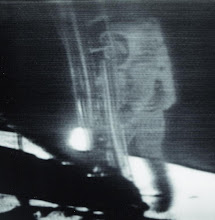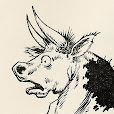
Thursday, February 26, 2009
Pylon


Noting with sadness the death yesterday of Randy Bewley, guitarist for the band Pylon. Pylon was formed by art students as an art project, more or less, using music, and was a very exciting part of the fertile music scene in Athens, GA in the late 70s and early 1980s. Members of both the B52s and REM have asserted that the best band to ever come out of Athens was Pylon. They were clever, innovative, never cynical and they would make you DANCE. Michael Lachowski, the bass player, is one of the more remarkable and versatile artists I've known. I borrowed his photos for the illustrations here.
Condolences to Randy's family and bandmates Michael, Vanessa Brisco, and Curtis Crowe. He will be remembered with admiration and appreciation.
Labels:
art bands,
Athens GA,
B52s,
Michael Lachowski,
music,
Pylon,
Randy Bewley,
REM
Wednesday, February 25, 2009
Tuesday, February 24, 2009
Black and White Photography

A photograph that is evidence of more than it pictures. This proof photo of a young black girl is stamped "Hollywood Studio, Exclusively for Colored." The owner of the studio, who also was black, worked in Jacksonville, Florida and Atlanta, Georgia. Presumably, the marketing strategy was meant to appeal to pride rather than to discriminate. No date is given, but I think it's likely from before the Civil Rights Act of 1964.
Monday, February 23, 2009
Friday, February 20, 2009
Busted Banks, Bad Checks


In a box of personal papers found at an estate sale, a bounced check and an explanatory note from the Federal Reserve Bank of Richmond, which reported that "we are advised that that bank is closed." The check is dated December 1931, and the US economy was well into the hard times that followed the crash of the stock market in 1929. The young man who wrote the check was in college in Alabama at the time. He saved similar notices and returned checks from other failed banks where he had accounts, including checks to the barber shop, the college bookstore, and his boarding house. The Federal Reserve Bank considerately attached this boilerplate note to each check with a straight pin before returning them to him. The postcard below, from the University of North Carolina collections, shows the failed bank in better days.
The happy ending is that the economy eventually recovered and he went on to a successful career in business. But I think it's telling that he never discarded these reminders of an unnerving time in his life and that of America.
Thursday, February 19, 2009
Animated Neon Sign

Yesterday's post of the bar mural got me to thinking about signage, and I have to share one of my all-time favorites. This sign in Memphis, TN is nominated in the category of animated neon signage, and features the walking man's busy legs, the whirling blades and flying grass clippings. The little forties cottage is a cherry on top. This picture may have been taken by my friend, the artist John Baeder. In addition to his body of work relating to diners and the glories of the American roadside, John has amassed an incredible archive of photographs of signs, a small part of which is included in his book Sign Language. If we're lucky he'll publish another volume. Dozens that he's sent to me are mixed up in my own modest accumulation.
As a child I was greatly impressed by a similar sign for Gordon's potato chips, with spinning wheels under a little panel delivery truck and a moving highway beneath it. Another memorable one was the Robin Hood Motel on US 41, in which the famous bandit drew his bow and fired an arrow.
Labels:
advertising,
Americana,
John Baeder,
Memphis,
neon signs,
Weakley Equipment
Wednesday, February 18, 2009
Bar Mural

This mural was painted on the cinderblock wall of a humble roadside bar, somewhere near Valdosta, Georgia. I took the photo sometime in the 1980s. I didn't go inside, but the image must be a representation of the interior, almost as if the artist made the wall transparent.
It's doubtful that it still exists except in this image.
A thing of beauty is a joy forever.
Monday, February 16, 2009
Saturday, February 14, 2009
Friday, February 13, 2009
Thursday, February 12, 2009
Glass




It's not always easy to make a good photograph of an opaque object. These pictures of clear glass laboratory devices must have required special talent in lighting. I bought them in appreciation of the beauty of the photos themselves, but found that the back story was just as impressive.
All of them are part of a bound notebook which served as a glass blower's application for promotion. He worked for a major American industrial lab. This artisan, after 26 years of work experience as a Laboratory Mechanic making these objects, applied to be promoted to Technician. These extremely specialized devices are his one-of-a-kind creations made to the specifications of scientists. His incredible skill in realizing the devices needed for their experiments is astonishing. I'm guessing that he got the promotion he wanted. The photographer is not credited.
Wednesday, February 11, 2009
Bed, Buried and Beyond

One of the things that sparked my interest in vernacular arts was my early exposure to decorated graves at an African American church in rural Georgia. Grave markers, from pyramids to mausoleums to uninscribed slabs of rock, have always provoked fascination with the limitless creativity exhibited in our last, permanent memorials. Have you ever seen the fantasy caskets from Ghana? It's a shame they're buried. All this was brought to mind by the snapshot shown here, which shows someone who chose to be buried in their bed. The inscription on the back identifies it as the grave of a Native American in Fort Washakie, Wyoming.
Tuesday, February 10, 2009
Orange Efficiency

This snapshot of a structure built in the shape of an orange was found without any information as to its location, who created it, or its purpose. I like the curved slot doorway and that the surface is pebbled just like orange rind. Ma and Pa are both smiling.
Monday, February 9, 2009
Slingshot

The simplest objects can embody excellent design. This carved wooden slingshot is particularly satisfying, being all that it needs to be but no more. The wood is smooth; it fits well in the hand and is stout enough to last. Found in North Carolina. Not signed, but it should be.
Labels:
carving,
folk art,
form and function,
minimalism,
slingshot
Friday, February 6, 2009
Laughing at Spirit Photography


Manipulated images have been used to deceive people for a long time. The fad of spirit photography around the turn of last century was responsible for separating a lot of gullible people from their money. Have a look at this goofy example from a real photo postcard. Below it is a leaf from an autograph book from the same era, a little doggerel from a skeptic.
Labels:
bad poetry,
manipulated images,
rppc,
spirit photograph
Thursday, February 5, 2009
Rabbits Against Snow

This image is from a real photo postcard, and was taken on today's date 98 years ago. The contrast of black rabbits against the snowy landscape is lovely, I think. It's somewhat reminiscent of the work of the contemporary photographer Masao Yamamoto.
However, there's something else going on here besides just being visually compelling. The rabbits are running, ears alert, agitated. Scratched into the negative is "Rabbit Drive 2/5/11, Near Lakeview Ore, 1811 Rabbits Killed in Pen."
The Nevada-California-Oregon Railroad, in an attempt to develop the land that its railroad served, hired a Russian man who relocated 25 Russian families to this outlying area. Rabbit drives became a regular winter occupation, with whole carloads of meat being shipped to a tamale factory in San Francisco. The enterprise gradually failed.
The postcard was mailed to someone, and the message on the back is about renting a saddle, making no mention of the photograph or the event.
Labels:
rabbits,
real photo postcard,
snow,
vernacular photography,
Yamamoto
Wednesday, February 4, 2009
Tuesday, February 3, 2009
Dilmus Hall Decorated Frame and Photo

Mr. Dilmus Hall of Athens, GA remains among the most under appreciated of all the American self-taught artists. His sculpture and drawings are a delight for all those fortunate enough to have experienced them. He also made yard art installations surrounding of his modest cinder block house, including the - for this viewer - seminal "Shoe that Rode the Howling Tornado," a single high heel shoe presented in a vitrine made of a salvaged aquarium, installed above his mailbox.
This Polaroid photograph of his friend is housed in a paint-decorated frame and cover glass.
Labels:
Athens,
Dilmus Hall,
folk art,
self-taught,
yard art
Monday, February 2, 2009
Light and Dark

There was no context for this found photograph, so I have no clue of its origin. Loving black and white, or light and dark, imagery as I do, though, it was compelling. It seems to involve a long exposure time, and instead of being light reflected from a subject, the light is generated by the subject. Could it be anti-aircraft fire and tracers?
Subscribe to:
Comments (Atom)










